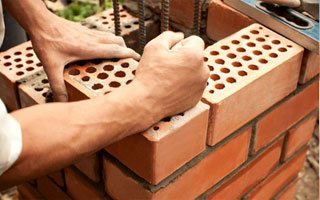Premier Roofing Contractor Services for Your Home
Premier Roofing Contractor Services for Your Home
Blog Article
Opening the Secrets of Lasting Masonry Building Practices for Eco-Friendly Buildings
Among the myriad techniques to environmentally friendly structure, sustainable stonework building and construction stands out as a reliable and durable method that holds a riches of untapped capacity. From the option of materials to ingenious building methods, the keys to achieving sustainability within masonry building are diverse and interesting.
Benefits of Lasting Masonry Building And Construction
Embracing lasting masonry building and construction practices not just reduces ecological impact however also supplies long-lasting financial benefits to building contractors and neighborhoods. By making use of products like recycled blocks, blocks, and rocks, contractors can significantly reduce the carbon footprint of their tasks while advertising resource efficiency. Furthermore, sustainable masonry construction techniques, such as correct insulation and thermal mass properties, can enhance energy efficiency within buildings, leading to lowered functional prices gradually.
In addition, the resilience and resilience of masonry structures add to long-term financial advantages. Structures created using sustainable stonework practices frequently require less maintenance and repair work, equating to cost savings for contractors and homeowner. The longevity of masonry products additionally ensures that frameworks continue to be secure and safe, minimizing the demand for constant renovations or substitutes.
Eco-Friendly Stonework Products
Making use of environmentally friendly masonry materials is a crucial action in the direction of boosting the sustainability of building and construction techniques and minimizing environmental effect while making the most of long-term economic benefits. Lasting masonry products are sourced, generated, and made use of in a fashion that reduces general ecological influence. Materials such as recycled bricks, recovered rock, and sustainable cinder block are becoming significantly preferred selections for eco-conscious builders. Recycled blocks, as an example, not only divert waste from land fills however likewise require less power to generate compared to new blocks. Redeemed rock offers an one-of-a-kind visual appeal while lowering the need for brand-new quarrying. Lasting concrete obstructs integrate recycled accumulations and may include improved insulation homes, contributing to energy performance in structures.
Additionally, natural products like adobe, rammed planet, and straw bundles provide excellent thermal mass homes, lowering the need for home heating and cooling down energy. These materials are often locally available, promoting regional economies and decreasing transportation-related carbon emissions. By selecting environment-friendly masonry materials, construction projects can significantly reduce their ecological impact and add to the development of healthier, much more sustainable built environments.
Energy-Efficient Stonework Strategies
Energy performance plays a critical function in enhancing the sustainability of stonework building and construction methods. One vital energy-efficient masonry technique is the usage of thermal mass, which includes incorporating thick products like concrete or brick into the structure's framework to take in and keep heat.

Developments in Sustainable Masonry
Current innovations in sustainable stonework practices have caused ingenious techniques that are reshaping the building industry. One such technology is the development of self-healing concrete, which makes use of microorganisms installed within the concrete to heal cracks autonomously. This breakthrough not just lowers upkeep expenses but additionally boosts the resilience of masonry structures, adding to their sustainability.
One more noteworthy innovation is using recycled accumulations in masonry construction - masonry contractor. By incorporating products such as crushed ceramic waste or recycled glass into concrete blends, builders can lower the ecological influence of building and construction tasks while keeping architectural integrity. This practice not just draws away waste from garbage dumps but additionally preserves natural deposits, making it an essential development in lasting stonework building
In addition, the combination of digital style tools, such as Building Details Modeling (BIM), is changing the means stonework structures are planned and built. BIM permits for even more precise computations, decreased product waste, and enhanced power performance, ultimately resulting in even more sustainable structure techniques. These technologies jointly indicate a promising future for sustainable masonry building and construction in the period of look at this website environment-friendly structures.
Future Trends in Masonry Sustainability
With the ingenious strides made in sustainable stonework practices, the future patterns in stonework sustainability are poised to additional transform the construction industry. One of the key trends forming the future of masonry sustainability is the increased combination of technology. Innovations such as Structure Information Modeling (BIM) and online truth simulations are being used to optimize masonry building and construction processes, causing reduced material waste and boosted power efficiency in buildings.
Moreover, the growth of novel lasting basics products is set to play a substantial role in improving the eco-friendliness of stonework construction. masonry contractor. Developments like self-healing concrete, recycled accumulations, and bio-based binders are obtaining grip for their ability to reduce environmental influence while maintaining structural stability

Conclusion
In conclusion, sustainable stonework building and construction practices use numerous benefits for green buildings. masonry contractor. Advancements in lasting masonry are constantly being created to better enhance the environmental efficiency of structures.
Report this page